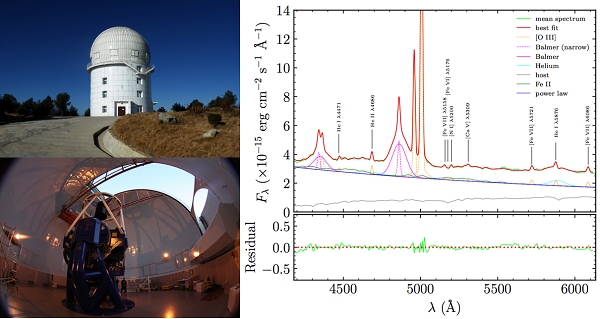Dr. LU Kai-Xing from Yunnan Observatories of Chinese Academy of Sciences with collaborator developed an active galactic nuclei (AGN) with ultrafast outflows monitoring project, and tentatively found the indirect evidence that the broad-line region (BLR) of AGN probably originates from disk wind.
This research, published online in The Astrophysical Journal, enables people to better understand the connections between disk wind and the BLR gas of AGN, and is helpful for developing the research on the origins and evolutions of the BLR.
AGN with ultra-fast outflows (UFOs) monitoring project cultivated by LU Kai-Xing is developing reverberation mapping (RM) campaign. This campaign intends to intensively monitor an abundant of AGNs with UFOs by spectroscopy, investigates the BLR kinematic structure of these AGNs, and probes the interaction between disk wind and the BLR. The project was undertaken with the Lijiang 2.4 meter telescope.
As the first outcome of the project, the research team found that the sub-Eddington accretion AGN of Mrk 79 appears to come out the faint state during monitoring period, the mean flux is approximately a magnitude fainter than historical record. Another interesting finding is that the BLR of Keplerian motion exists as outflow gas motion. All findings including UFOs, warm absorbers and kinematical signature of the high- and low-ionization BLR in Mrk 79 suggest that the BLR of Mrk 79 plausible originates from disk wind.
Based on the velocity-resolved RM, the researchers simultaneously constructed the velocity-resolved lag profiles of three broad-emission lines at the first time. ‘Our calibration method in flux and shape of spectrum makes full use of the advantages of long-slit spectrum observation, this breakthrough benefits from the credible spectral calibration.’ Said Dr. LU.
'Fully appreciated BLR physics is crucial for measuring the supermassive black hole mass with high precision and applying AGN to research cosmology. Many astronomers with increasing interest attempt to understand the physical origins and evolutions of the BLR, our research is proving a new approach to achieve the goal.’ Dr. LU Added.

Fig.1 2.4-m telescope (outdoor and indoor,left) of Lijiang observatory, Yunnan Observatories, decomposed spectrum (observed by Lijiang 2.4-m telescope) with multi-components (right).(Image by LU Kaixing)
Contact:
LU Kaixing, YNAO, CAS
lukx@ynao.ac.cn